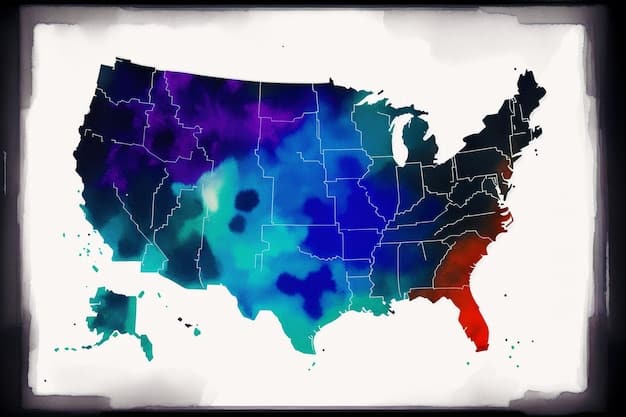State Abortion Laws: Current Restrictions & Future Outlook in the US

State abortion laws in the US vary significantly, ranging from outright bans to comprehensive access, with current restrictions including gestational limits, mandatory waiting periods, and parental consent laws, while future possibilities hinge on ongoing legal challenges and potential legislative changes influenced by public opinion and judicial appointments.
The landscape of state abortion laws: what are the current restrictions and future possibilities? is constantly shifting in the United States, influenced by legal challenges, political dynamics, and evolving societal values. Understanding where each state stands on abortion rights is crucial for anyone concerned about reproductive healthcare access.
Understanding the Current State of Abortion Laws
Navigating the intricacies of abortion laws across the United States requires a comprehensive understanding of the current legal landscape. Each state has the power to regulate abortion within its borders, leading to a patchwork of laws that vary widely in scope and severity.
These laws impact access to abortion services and the experiences of individuals seeking reproductive healthcare.
Gestational Limits
One of the most common restrictions on abortion is gestational limits. These laws prohibit abortions after a certain point in pregnancy, typically measured from the first day of the woman’s last menstrual period.
Some states have early gestational limits, such as six weeks, while others allow abortions up to viability, which is generally considered to be around 24 weeks.
- Six-week bans: Several states have enacted laws that ban abortions as early as six weeks of pregnancy, often before many women even know they are pregnant.
- Viability limits: Many states adhere to the standard set by *Roe v. Wade*, which allows abortions up to the point of fetal viability.
- Exceptions: Some gestational limit laws include exceptions for the life or health of the pregnant woman.

Mandatory Waiting Periods and Counseling
Another common type of restriction is mandatory waiting periods. These laws require women to wait a specific amount of time, usually 24 or 72 hours, between their initial consultation and the abortion procedure.
During the initial consultation, women may also be required to receive state-mandated counseling that includes biased or misleading information about abortion.
- 24-hour waiting periods: Many states require a 24-hour waiting period between the initial consultation and the abortion procedure.
- 72-hour waiting periods: Some states have longer waiting periods, such as 72 hours.
- State-mandated counseling: In some states, women are required to receive counseling that may include inaccurate information about the risks of abortion or the development of the fetus.
Parental Involvement Laws
Parental involvement laws require minors seeking abortions to either obtain parental consent or receive a judicial bypass, which is a court order allowing them to have an abortion without parental involvement.
These laws can create significant barriers to access for young people, particularly those who live in abusive or dysfunctional households.
In summary, the current state of abortion laws is complex and varies widely. States impose different gestational limits, waiting periods, parental involvement laws, and regulations on abortion providers.
The Impact of the Dobbs Decision
The overturning of *Roe v. Wade* in *Dobbs v. Jackson Women’s Health Organization* fundamentally altered the legal landscape of abortion in the United States. This decision eliminated the federal constitutional right to abortion, allowing individual states to regulate or ban abortion as they see fit.
This has led to a dramatic increase in the number of states with abortion bans or severe restrictions, creating significant challenges for individuals seeking abortion care.
Trigger Laws and Abortion Bans
Following the *Dobbs* decision, many states with trigger laws—laws designed to take effect automatically if *Roe v. Wade* were overturned—immediately banned or severely restricted abortion.
These laws have created abortion deserts, where individuals must travel long distances, sometimes across state lines, to access abortion services.
- Near-total bans: Some states have enacted near-total bans on abortion, with very limited exceptions for the life of the pregnant woman.
- Six-week bans: As mentioned earlier, several states have six-week bans that have gone into effect following the *Dobbs* decision.
- Legal challenges: Many of these bans are facing legal challenges, leading to ongoing uncertainty about the future of abortion access in these states.
Impact on Access and Healthcare Providers
The *Dobbs* decision has had a profound impact on abortion access and healthcare providers. Many clinics have been forced to close or suspend abortion services, leaving individuals with fewer options for care.
Healthcare providers also face legal risks and uncertainty, which can make it difficult for them to provide comprehensive reproductive healthcare.
- Clinic closures: Many abortion clinics have been forced to close or suspend services due to abortion bans and restrictions.
- Increased travel distances: Individuals seeking abortion care may have to travel hundreds of miles to reach a state where abortion is legal.
- Legal risks for providers: Healthcare providers face legal risks for providing abortion care, including criminal penalties and civil lawsuits.
Disparities in Access
The *Dobbs* decision has exacerbated existing disparities in access to abortion care. Individuals who are low-income, people of color, and those living in rural areas are disproportionately affected by abortion bans and restrictions.
These individuals may face significant barriers to accessing abortion care, including financial constraints, lack of transportation, and limited access to healthcare services.
In conclusion, the *Dobbs* decision has fundamentally reshaped the legal landscape of abortion in the United States. It has led to a dramatic increase in the number of states with abortion bans or severe restrictions.

Future Possibilities: Legal and Legislative Battles
The future of abortion rights in the United States will depend on a combination of legal and legislative battles. Ongoing legal challenges to abortion bans and restrictions, as well as potential legislative changes at the state and federal levels, could significantly impact access to abortion care.
Understanding these potential future possibilities is essential for advocates, policymakers, and individuals who care about reproductive healthcare access.
Ongoing Litigation
Several states are currently facing legal challenges to their abortion bans and restrictions. These challenges are often based on state constitutional rights to privacy or equal protection.
The outcomes of these cases could significantly impact the future of abortion access in these states.
State-Level Legislation
State legislatures will continue to play a key role in shaping abortion policy. Some states may seek to enact new abortion bans or restrictions, while others may seek to protect or expand abortion access.
The composition of state legislatures and the political climate in each state will influence the outcome of these legislative battles.
- Protective legislation: Some states may enact laws to protect abortion access, such as codifying the right to abortion in state law or expanding access to abortion services.
- Restrictive legislation: Other states may seek to enact new abortion bans or restrictions, such as gestational limits, mandatory waiting periods, or parental involvement laws.
- Ballot initiatives: In some states, voters may have the opportunity to vote on abortion-related ballot initiatives, which could directly impact abortion policy.
Federal Action
At the federal level, there are several potential avenues for action on abortion policy. Congress could pass legislation to protect or restrict abortion access, although such legislation may face significant political challenges.
The outcome of presidential and congressional elections could also affect the future of abortion policy at the federal level.
- Legislative efforts: Congress could pass legislation to protect abortion access, such as the Women’s Health Protection Act, which would codify the right to abortion in federal law.
- Executive action: The President could take executive action to protect abortion access, such as issuing executive orders or directing federal agencies to take certain actions.
- Judicial appointments: The composition of the Supreme Court could also affect the future of abortion policy, as the Court could be asked to rule on future abortion-related cases.
In summary, the future of abortion rights in the United States is highly uncertain. Ongoing litigation, state-level legislation, and federal action will all play a role in shaping abortion policy in the years to come.
The Role of Public Opinion and Advocacy
Public opinion and advocacy efforts play a crucial role in shaping the future of abortion rights. Public support for abortion access can influence policymakers and shape the political climate surrounding abortion policy.
Advocacy organizations work to educate the public, mobilize support for abortion rights, and lobby policymakers to protect or expand abortion access.
Public Opinion
Public opinion on abortion is complex and nuanced. While a majority of Americans support abortion access in at least some circumstances, there are significant differences in opinion based on factors such as political affiliation, religious beliefs, and demographics.
Understanding public opinion on abortion is essential for advocates and policymakers who seek to shape abortion policy.
- Support for abortion access: A majority of Americans support abortion access in at least some circumstances.
- Differences in opinion: There are significant differences in opinion on abortion based on factors such as political affiliation, religious beliefs, and demographics.
- Shifting attitudes: Public opinion on abortion can shift over time in response to events such as the *Dobbs* decision.
Advocacy Organizations
Numerous advocacy organizations work to protect or restrict abortion access. These organizations engage in a variety of activities, including public education, grassroots organizing, lobbying, and litigation.
Understanding the role of advocacy organizations is essential for understanding the dynamics of the abortion debate.
- Protecting abortion access: Organizations such as Planned Parenthood and the National Abortion Federation work to protect abortion access and expand access to reproductive healthcare services.
- Restricting abortion access: Organizations such as the National Right to Life Committee and the Susan B. Anthony List work to restrict abortion access and promote alternatives to abortion.
- Legal advocacy: Organizations such as the American Civil Liberties Union (ACLU) and the Center for Reproductive Rights engage in litigation to protect or restrict abortion access.
Grassroots Movements
Grassroots movements play a crucial role in shaping public opinion and influencing policymakers on abortion policy. These movements involve ordinary people organizing and mobilizing to advocate for their beliefs.
Grassroots movements can be a powerful force for change on abortion policy.
In conclusion, public opinion and advocacy efforts play a crucial role in shaping the future of abortion rights in the United States. Public support for abortion access and the efforts of advocacy organizations and grassroots movements can influence policymakers and shape the political climate surrounding abortion policy.
Navigating Abortion Laws: Resources and Support
Navigating the complex landscape of abortion laws can be challenging, especially for individuals seeking abortion care. Fortunately, numerous resources and support services are available to help individuals understand their rights and access the care they need.
These resources and services include:
Reproductive Health Organizations
Organizations like Planned Parenthood offer a range of reproductive health services, including abortion care, contraception, and STI testing. They also provide information and resources on abortion laws and access.
These organizations can be valuable resources for individuals seeking reproductive healthcare services.
- Direct services: Planned Parenthood and other reproductive health organizations provide direct services such as abortion care, contraception, and STI testing.
- Information and resources: These organizations also provide information and resources on abortion laws and access.
- Advocacy: Planned Parenthood and other reproductive health organizations advocate for policies that protect and expand access to reproductive healthcare.
Legal Aid Organizations
Organizations like the American Civil Liberties Union (ACLU) and the Center for Reproductive Rights provide legal assistance to individuals seeking abortion care. They also engage in litigation to protect abortion rights.
These organizations can be valuable resources for individuals who need legal assistance related to abortion.
- Legal assistance: The ACLU and the Center for Reproductive Rights provide legal assistance to individuals seeking abortion care.
- Litigation: These organizations engage in litigation to protect abortion rights.
- Education: The ACLU and the Center for Reproductive Rights educate the public and policymakers about abortion law and policy.
Abortion Funds
Abortion funds provide financial assistance to individuals who cannot afford the full cost of an abortion. These funds can help individuals overcome financial barriers to accessing abortion care.
Abortion funds are a crucial resource for individuals who are low-income or face other financial challenges.
In summary, navigating the complex landscape of abortion laws can be challenging, but numerous resources and support services are available to help individuals understand their rights and access the care they need.
Conclusion: The Ongoing Debate and Future Outlook
The debate over state abortion laws: what are the current restrictions and future possibilities? remains one of the most contentious and polarizing issues in American politics. The legal landscape is constantly evolving, with ongoing legal challenges, legislative changes, and shifts in public opinion all shaping the future of abortion access.
Understanding the current state of abortion laws, the impact of the *Dobbs* decision, and the potential future possibilities is essential for anyone concerned about reproductive healthcare access. Staying informed and engaged in the political process is crucial for shaping the future of abortion rights in the United States.
Key Point
Brief Description
⚖️ Current Restrictions
A mix of gestational limits, waiting periods, and parental consent laws varies significantly by state.
💥 Impact of Dobbs
Overturning Roe v. Wade led to abortion bans in many states, creating access disparities.
🔮 Future Battles
Legal challenges and legislative efforts at state and federal levels will shape abortion policy.
📢 Public Opinion
Public views and advocacy greatly influence the political climate around abortion laws.
Frequently Asked Questions
▼
A gestational limit is a restriction that prohibits abortions after a certain point in pregnancy, typically measured from the last menstrual period. These limits vary by state.
▼
The Dobbs decision overturned Roe v. Wade, eliminating the federal constitutional right to abortion and allowing individual states to regulate or ban abortion as they see fit.
▼
Parental involvement laws require minors seeking abortions to either obtain parental consent or receive a judicial bypass, allowing them to have an abortion without parental involvement.
▼
Advocacy organizations work to educate the public, mobilize support for abortion rights, and lobby policymakers to protect or expand abortion access and influence public opinion to affect abortion laws.
▼
Resources like Planned Parenthood, legal aid organizations such as the ACLU, and abortion funds offer services and support for individuals seeking information and abortion care.
Conclusion
In summary, understanding the complexities surrounding state abortion laws is more crucial than ever. By staying informed and supporting organizations dedicated to reproductive rights, individuals can actively participate in shaping the future of abortion access in the United States.
Read more content





